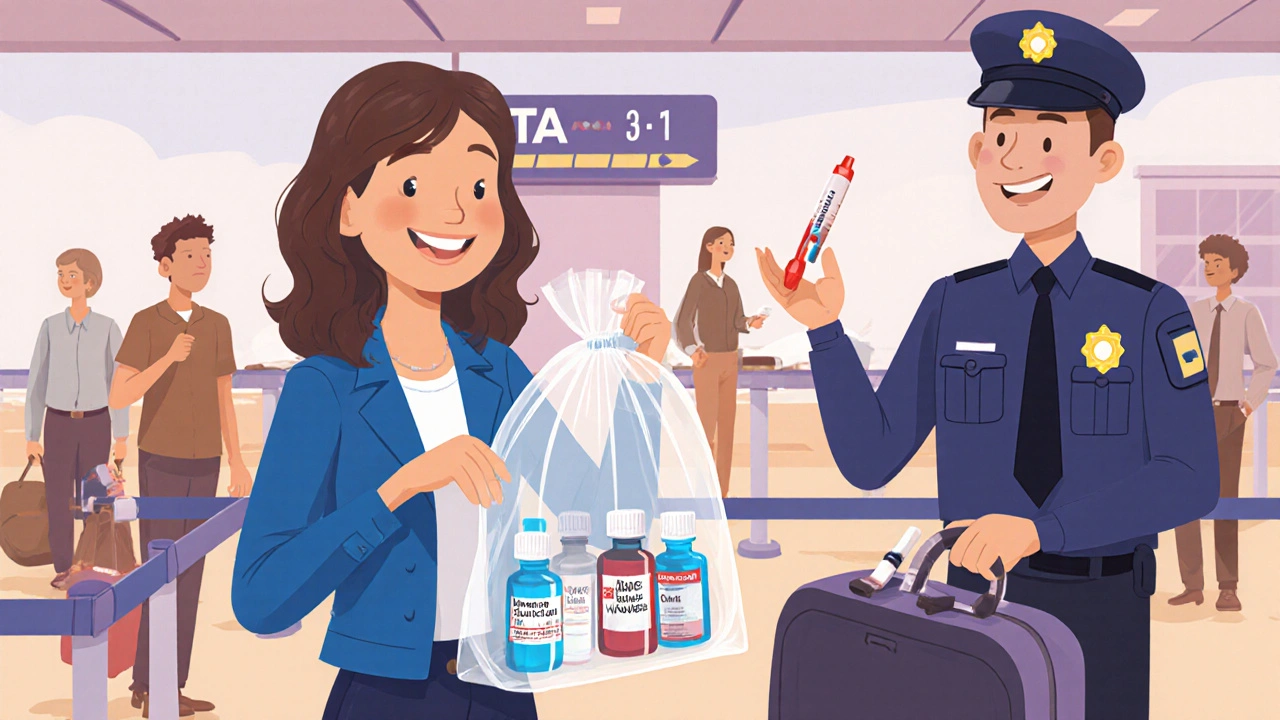When you're flying with airport security for meds, the set of rules and procedures that govern how travelers can carry medications through TSA checkpoints. Also known as TSA medication rules, it's not about hiding your pills—it's about showing them the right way. Millions of people fly with prescriptions, over-the-counter drugs, and supplements every year. Most make it through without a hitch. But a surprising number get stopped, delayed, or even have their meds confiscated because they didn’t follow the basics.
TSA medication rules, the guidelines enforced by the Transportation Security Administration for carrying drugs on U.S. flights don’t require you to keep meds in original bottles—but they do demand clarity. If you're carrying insulin, thyroid pills, or heart medication, you’re allowed to bring them in your carry-on. The key is being ready to explain what they are. A pharmacy label, a doctor’s note, or even a photo of your prescription on your phone can save you minutes—or a missed flight. You don’t need to declare every pill, but if an officer asks, you should be able to point to your meds and say, "This is my blood pressure medicine. Here’s the bottle."
What about liquids? pill containers, the small bottles, blister packs, or travel cases used to store oral medications during travel are fine in any quantity. But if you’re bringing liquid meds like cough syrup or liquid antibiotics, they’re exempt from the 3-1-1 rule. You can carry more than 3.4 ounces—but you must tell the officer at the checkpoint. Same goes for injectables: insulin pens, EpiPens, or testosterone injections? All allowed. Just keep them in your carry-on, and be ready to show them separately. Don’t pack them in checked luggage. If your bag gets lost, you could be stranded without your meds.
Supplements are trickier. You can bring vitamin D, magnesium, or melatonin—no problem. But if you’re carrying something unusual, like high-dose melatonin or a herbal extract that looks like a powder or gel, be prepared for extra screening. Some supplements are flagged because they resemble controlled substances. A simple label with the ingredient list helps. And never try to disguise meds as candy or food. That’s not clever—it’s a red flag.
International travel adds another layer. The U.S. lets you bring meds for personal use, but other countries don’t always agree. Some ban common painkillers like codeine or even pseudoephedrine. Before you fly overseas, check the destination country’s rules. A few have strict lists—like Japan, which bans many cold medicines. Carry a letter from your doctor in English and the local language if possible. It’s not required, but it prevents long waits at customs.
What you won’t find in the rules? A requirement to list every pill in your bag. You don’t need a spreadsheet. You don’t need to pre-register. Just keep your meds accessible, labeled, and honest. If you’re traveling with a child, elderly parent, or someone with a complex regimen, bring a printed list with names, doses, and why they’re taken. It’s not just for security—it’s for safety.
And yes, you can bring your meds in a pill organizer. Many people do. But if it’s a 7-day divider with no labels, expect questions. Fill it with your actual pills, not generics from a different brand, and keep the original bottle nearby. That’s all it takes.
There’s no magic trick to flying with meds. It’s not about fear—it’s about preparation. The system works when you’re clear, calm, and cooperative. You’re not a suspect. You’re a traveler who needs their medicine. And you have every right to bring it.
Below, you’ll find real advice from people who’ve been through it: how to talk to pharmacists about travel meds, what to do when your prescription runs out abroad, and how to handle emergency refills mid-trip. These aren’t theory pieces—they’re lived experiences that cut through the noise and give you what actually works.

Learn how to fly with liquid medications without delays. TSA allows unlimited prescription liquids if properly labeled and declared. Follow these simple steps to clear security quickly and avoid common mistakes.
read more